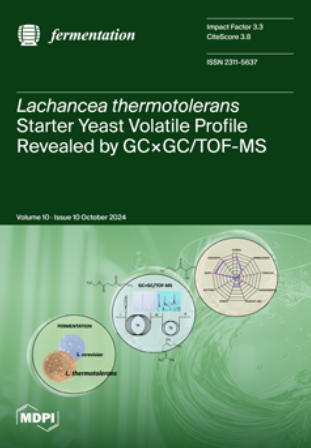酵母接种方式对长相思葡萄酒代谢物组成的影响
IF 3.3
3区 农林科学
Q2 BIOTECHNOLOGY & APPLIED MICROBIOLOGY
引用次数: 0
摘要
来自文献的证据表明,使用活性干酵母(ADY)或新鲜制备的酵母培养物的不同接种策略会影响葡萄酒酵母的性能,从而改变生物质和发酵过程中产生的许多初级和次级代谢物。在这里,我们研究了不同的接种方法如何改变发酵行为和代谢的商品酒酵母。以商品长相思(SB)葡萄汁为原料,采用酿酒酵母X5两种不同的接种物制备方案进行发酵:商用ADY复水化和在丰富的实验室培养基中制备预接种物。我们还确定了不同数量的酵母细胞接种(从1 × 106到1 × 1012不等)和连续接种对发酵和最终产物形成的影响。酵母接种方式和细胞数对发酵时间有显著影响。主成分分析(PCA)显示了两种接种方法生产的葡萄酒之间的分离模式。接种方法影响了氨基酸和不同香气化合物(包括乙酯和乙酸酯)的产生。不同接种方式和接种细胞数量对葡萄酒中硫醇、3-巯基己醇(3MH)和4-甲基-4-巯基己醇-2-酮(4MMP)含量均有影响,而对3-巯基己醇乙酸(3MHA)的产量影响不大。利用这些量化的代谢物进行途径分析使我们能够确定最重要的途径,其中大多数与中心碳代谢有关,特别是涉及氮和硫代谢的代谢途径。综上所述,这些结果表明,在生产不同风格的葡萄酒时,应考虑接种方法和接种细胞的数量。本文章由计算机程序翻译,如有差异,请以英文原文为准。
The Effect of Yeast Inoculation Methods on the Metabolite Composition of Sauvignon Blanc Wines
Evidence from the literature suggests that different inoculation strategies using either active dry yeast (ADY) or freshly prepared yeast cultures affect wine yeast performance, thus altering biomass and many primary and secondary metabolites produced during fermentation. Here, we investigated how different inoculation methods changed the fermentation behaviour and metabolism of a commercial wine yeast. Using a commercial Sauvignon blanc (SB) grape juice, fermentation was carried out with two different inoculum preparation protocols using Saccharomyces cerevisiae X5: rehydration of commercial ADY and preparation of pre-inoculum in a rich laboratory medium. We also determined the effect of different numbers of yeast cells inoculation (varying from 1 × 106 to 1 × 1012) and successive inoculation on fermentation and end-product formation. The yeast inoculation method and number of cells significantly affected the fermentation time. Principal component analysis (PCA) using 60 wine metabolites showed a separation pattern between wines produced from the two inoculation methods. Inoculation methods influenced the production of amino acids and different aroma compounds, including ethyl and acetate esters. Varietal thiols, 3-mercaptohexanol (3MH), and 4-methyl-4-mercaptopentan-2-one (4MMP) in the wines were affected by the inoculation methods and numbers of inoculated cells, while little impact was observed on 3-mercaptohexyl acetate (3MHA) production. Pathway analysis using these quantified metabolites allowed us to identify the most significant pathways, most of which were related to central carbon metabolism, particularly metabolic pathways involving nitrogen and sulphur metabolism. Altogether, these results suggest that inoculation method and number of inoculated cells should be considered in the production of different wine styles.
求助全文
通过发布文献求助,成功后即可免费获取论文全文。
去求助
来源期刊

Fermentation-Basel
BIOTECHNOLOGY & APPLIED MICROBIOLOGY-
CiteScore
3.80
自引率
18.90%
发文量
594
审稿时长
7 weeks
期刊介绍:
Fermentation-Basel is an international open access journal published by MDPI, focusing on fermentation-related research, including new and emerging products, processes and technologies, such as biopharmaceuticals and biotech drugs. The journal enjoys a good reputation in the academic community and provides a high-impact forum for researchers in the field of bioengineering and applied microbiology.
 求助内容:
求助内容: 应助结果提醒方式:
应助结果提醒方式:


